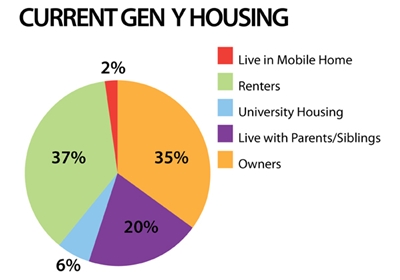For Gen Y, it’s not about the dream home, but the dream ‘hood

With the Gen Y generation, the largest demographic in U.S. history with 83-85 million born 1981-1989, coming of home-buying age, what is this going to mean for housing and the American Dream? The future looks pretty bright from a sustainability point of view…
More apartments. Using a recent Canadian housing study, “Drivers of Apartment Living in Canada for the Twenty-First Century“, which parallels trends in the U.S., one can see in the top graph on the left that apartments are on the rise. Why? They can’t afford to buy, as you can see in the middle graph. They haven’t built up their wealth to buy yet, and with the economic downturn, 30% are unemployed. School debt is also much larger, averaging $23,000, and banks now loan to people that can actually pay them back. It also means sharing apartments via multiple bedrooms to split the rent. They’re also delaying marriage, so no single-family suburban home with white picket fence. See “Renting the Dream” by Richard Florida.
Smaller homes. Why? They can’t afford anything larger, and besides, small is the new big, or micro lofts are the new mcmansions. 250 and 270 s.f. isn’t unheard of, and cities are changing their rules to accommodate them. Why not, if you can own your home in the neighborhood of your dreams. Ah, there’s the difference… it’s not about the dream home, but the dream neighborhood. Gen Yers are motivated by experiences (in an experience economy), not consumption, or home size. Smaller homes and apartments are both less expensive and easier to maintain, leaving more time and money for enjoying those experiences.
 Walkable, urban, transit-oriented. For Gen Yers, driving isn’t part of the American Dream anymore. Being connected is. That means walkable and transit-oriented, and that means downtowns and cities. Also, as far as connecting face-face, town squares and piazzas are the ultimate connectors in the built environment, especially with outdoor movies/dining/concerts in them.
Walkable, urban, transit-oriented. For Gen Yers, driving isn’t part of the American Dream anymore. Being connected is. That means walkable and transit-oriented, and that means downtowns and cities. Also, as far as connecting face-face, town squares and piazzas are the ultimate connectors in the built environment, especially with outdoor movies/dining/concerts in them.
Change is now. There is no waiting. If you have attainably-priced, walkable, urban, transit-oriented two-three bedroom apartments and micro lofts, Gen Yers are ready to move in asap, as the bottom graph shows. They’ll look online to find a job online that accommodates their living preferences, no more commuting… they not only can’t afford a car, they don’t want one.
An addition, based on a survey and illustrated in the graphic above, over one third of Gen Yers currently own their own home, and two-thirds expect to own their residences within five years, including over half the people who will still be in their 20s in 2015. Read more at the Urban Land Institute article, “Generation Y: America’s New Housing Wave”.

Leave a Reply